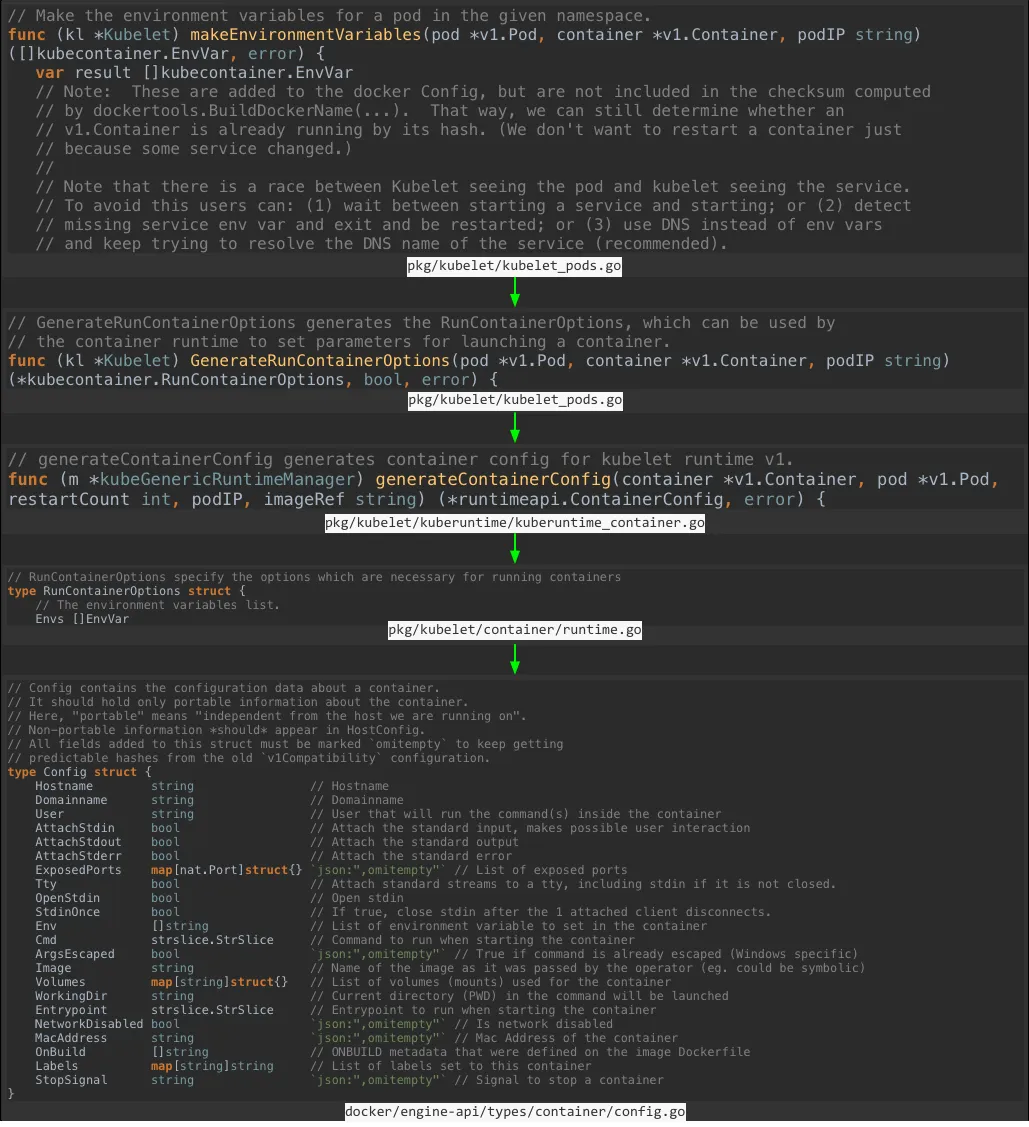前言
今天创建了两个 kubernetes 示例应用:
- k8s-app-monitor-test:启动 server 用来产生 metrics
- k8s-app-monitor-agent:获取 metrics 并绘图,显示在 web 上
注:相关的 kubernetes 应用manifest.yaml文件分别见以上两个应用的 GitHub。
当我查看 Pod 中的环境变量信息时,例如 kubernetes 中的 service k8s-app-monitor-test注入的环境变量时,包括了以下变量:
K8S_APP_MONITOR_TEST_PORT_3000_TCP_ADDR=10.254.56.68
K8S_APP_MONITOR_TEST_PORT=tcp://10.254.56.68:3000
K8S_APP_MONITOR_TEST_PORT_3000_TCP_PROTO=tcp
K8S_APP_MONITOR_TEST_SERVICE_PORT_HTTP=3000
K8S_APP_MONITOR_TEST_PORT_3000_TCP_PORT=3000
K8S_APP_MONITOR_TEST_PORT_3000_TCP=tcp://10.254.56.68:3000
K8S_APP_MONITOR_TEST_SERVICE_HOST=10.254.56.68
K8S_APP_MONITOR_TEST_SERVICE_PORT=3000
我们知道 Kubernetes 在启动 Pod 的时候为容器注入环境变量,这些环境变量将在该 Pod 所在的 namespace 中共享。但是既然使用这些环境变量就已经可以访问到对应的 service,那么获取应用的地址信息,究竟是使用变量呢?还是直接使用 DNS 解析来发现?下面我们从代码中来寻求答案。
如果不想看下面的文字,可以直接看图。

探索
docker 的docker/engine-api/types/container/config.go中的Config结构体中有对环境变量的定义:
// Config contains the configuration data about a container.
// It should hold only portable information about the container.
// Here, "portable" means "independent from the host we are running on".
// Non-portable information *should* appear in HostConfig.
// All fields added to this struct must be marked `omitempty` to keep getting
// predictable hashes from the old `v1Compatibility` configuration.
type Config struct {
Hostname string // Hostname
Domainname string // Domainname
User string // User that will run the command(s) inside the container
...
Env []string // List of environment variable to set in the container
Cmd strslice.StrSlice // Command to run when starting the container
...
}
Kubernetes 中在pkg/kubelet/container/runtime.go中的RunContainerOptions结构体中定义:
// RunContainerOptions specify the options which are necessary for running containers
type RunContainerOptions struct {
// The environment variables list.
Envs []EnvVar
// The mounts for the containers.
Mounts []Mount
// The host devices mapped into the containers.
...
}
Kubelet 向容器中注入环境变量的配置是在下面的方法中定义:
pkg/kubelet/kuberuntime/kuberuntime_container.go
// generateContainerConfig generates container config for kubelet runtime v1.
func (m *kubeGenericRuntimeManager) generateContainerConfig(container *v1.Container, pod *v1.Pod, restartCount int, podIP, imageRef string) (*runtimeapi.ContainerConfig, error) {
opts, _, err := m.runtimeHelper.GenerateRunContainerOptions(pod, container, podIP)
...
// set environment variables
envs := make([]*runtimeapi.KeyValue, len(opts.Envs))
for idx := range opts.Envs {
e := opts.Envs[idx]
envs[idx] = &runtimeapi.KeyValue{
Key: e.Name,
Value: e.Value,
}
}
config.Envs = envs
return config, nil
}
kubelet 的pkg/kubelet/kubelet_pods.go的如下方法中生成了RunContainerOptions:
// GenerateRunContainerOptions generates the RunContainerOptions, which can be used by
// the container runtime to set parameters for launching a container.
func (kl *Kubelet) GenerateRunContainerOptions(pod *v1.Pod, container *v1.Container, podIP string) (*kubecontainer.RunContainerOptions, bool, error) {
...
opts := &kubecontainer.RunContainerOptions{CgroupParent: cgroupParent}
...
opts.Envs, err = kl.makeEnvironmentVariables(pod, container, podIP)
return opts, useClusterFirstPolicy, nil
}
我们再看下makeEnvironmentVariables(pod, container, podIP)方法中又做了什么(该方法也在pkg/kubelet/kubelet_pods.go文件中)。
// Make the environment variables for a pod in the given namespace.
func (kl *Kubelet) makeEnvironmentVariables(pod *v1.Pod, container *v1.Container, podIP string) ([]kubecontainer.EnvVar, error) {
var result []kubecontainer.EnvVar
// Note: These are added to the docker Config, but are not included in the checksum computed
// by dockertools.BuildDockerName(...). That way, we can still determine whether an
// v1.Container is already running by its hash. (We don't want to restart a container just
// because some service changed.)
//
// Note that there is a race between Kubelet seeing the pod and kubelet seeing the service.
// To avoid this users can: (1) wait between starting a service and starting; or (2) detect
// missing service env var and exit and be restarted; or (3) use DNS instead of env vars
// and keep trying to resolve the DNS name of the service (recommended).
...
}
该代码段比较长,kubernetes 究竟如何将环境变量注入到 docker 容器中的奥秘就在这里,按图索骥到了这里,从代码注释中已经可以得出结论,使用 DNS 解析而不要使用环境变量来做服务发现,究竟为何这样做,改天我们再详细解读。